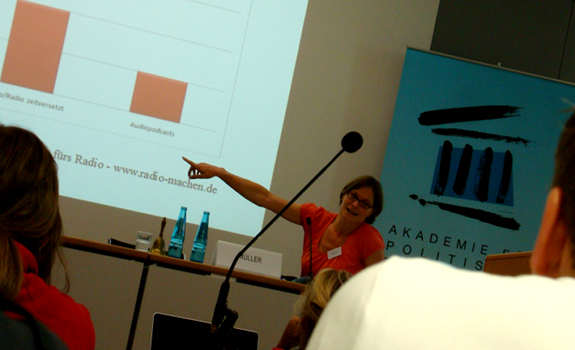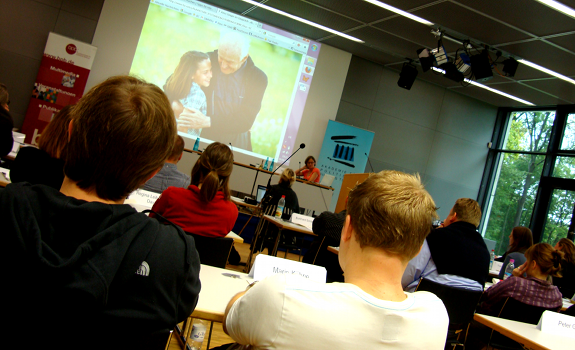Radio features are broadcast and gone forever. Not anymore! Audio slideshows make radio content sexy for your online listeners and drive long tail search engine traffic as well.
German radio journalist and author Sandra Müller thinks that audio slideshows are perfect to make radio visual and attractive online. “It’s a great way to show the pearls that we have in radio”, she said during the Tutzinger Radiotage. Therefore audio slideshows could be an alternative for podcasting, and give radio content a second, eternal life on the Internet.
Podcast popularity is declining
Only a small amount of people actually listens to podcasts. The ARD/ZDF-Onlinestudie (online study by German public broadcasters ARD and ZDF) confirms what we all know: the use of online video is much bigger than online audio. Of all German people that are online, 2% downloads a podcast once a week or more. This percentage has been 8% in the past. Online video seems an obvious way to enhance the lineair radio program, but Müller is more a fan of audio slideshows to add a visual dimension.
Audio slideshow genres
Some examples of different formats of audio slideshows to be used:
- Classic: one audio track, enhanced by one linear series of static photos
- Collage: montage of multiple music pieces, sound bits and interview clips
- Visualized feature: enhancing a radio feature through visual components
- Visualized interview: combining a radio interview with (moving) pictures
- Best of recycling: using radio broadcast material in a new way online
- Teaser: using online audio slideshows to promote on-air radio shows
Slideshows focus listener attention
“It incredible how strong it touches you” is Sandra Müller’s reason for loving audio slideshows. She explains that a major problem of audio on the Internet is that listeners are being distracted all the time. Other content on the web page and things that happen around them, take the attention away (“There is no anchor”). She assumes that photo slideshows keep people listening while they’re engaged by the constantly refreshed pictures – adding that she hasn’t found statistics so far. “It’s really hard, because apparently no-one seems eager to share how many of their website visitors click on audio slideshows.”

Audio slideshow fan Sandra Müller shows that podcasts are less popular than online video (photo: Thomas Giger)
Backsell radio content online
Audio slideshows can be used to backsell a station’s coverage of an important event. Local stations of the BBC reported about the incredible amount of snow that fell in the UK in December 2010. They decided to visually enhance audio that was already broadcast on the radio – using presenter airchecks, news bulletins, traffic reports, reporter features, sound bites and listener calls. All collected during a week and melded into one new audiovisual product. It’s a way of creating a long tail for radio content, because as Müller says: “the cool thing is that people still click on it today”.

Picture from the BBC News audio slideshow ‘Snowbound’, reworking radio into long tail web content (photo: BBC)
Slideshows demand less explanation
Radio journalists should be aware of the fact that a picture says more than a thousand words. Less is more in an audio slideshow, when it comes to spoken word. Sandra Müller advises to produce two audio-edits: one for the radio and one for the Internet; containing less explanation and description of what happens. To increase the dramatic effect at given point, it can be functional to say nothing and let music fill the gap, and let the images speak for themselves. But: “Be careful that you keep the essence of the original radio interview.”
Audio slideshow challenges
The main challenges for audio slideshows online are:
- Clearing rights for music that is included
- Using for more radio genres than personal portraits
- Avoiding conflict between theatre of mind and actual images
- Teasing from on-air towards online without emphasizing radio’s deficit (lack of visuals)
Audio slideshow production workflow
In a multitasking journalism world, reporters are usually on their own. So how to record audio and take photos simultaneously? “I take pictures after or during the interview; I once used clip-on microphones to keep my hands free.” Müller also mentions another useful method: record the interview, take pictures that are related to it, and then show these to the interviewee – while recording his comments on the photos you’ve taken. These bits are like a voice-over, done by the person you’ve interviewed.

Radio journalist Sandra Müller sees audio slideshows as visual anchors for radio audiences (photo: Thomas Giger)
Radio people’s creative playground
Audio slideshows offer a lot of creative possibilities for radio journalists and feature & documentary producers. In Sandra Müller’s experience, creating an audio slideshow is less complex – and the work is done much faster – compared to building a television feature. The reason? There is not always a need to actually show an image. “Sometimes it’s really beautiful to fade to black or white on a point where we audio producers say: there’s that sound bite where your heart stops for a moment!”
Audio slideshow benefits
The main benefits of audio slideshows for radio on the Internet:
- Creates timeless long tail value online
- Adds emotional layers to radio content
- Gets closer to people and their personal story
- Gives orientation because listeners see things happen
- Keeps focus on story by engaging easily distracted people
- Makes backsells of already broadcast radio content possible
- Enables efficient production (faster and easier than video editing)
Read also: Good Small Talkers Are Good Radio Presenters
 About
About
Sandra Müller is a freelance radio journalist, reporter, presenter and author. She works for the German SWR (Südwestrundfunk) and is one of the founders of FAIR RADIO, an initiative to give radio more credibility by being transparent and honest towards listeners. Müller has written the text guide Radio machen (an introduction to making radio) and shares additional tips on her weblog, which can be found at www.radio-machen.de.





Hello Sandra,
Wow.
I’ve been producing audio slideshow demo reels for HDAudioPlus for almost 2 years now. Quite frankly, after competing unsuccessfully on YouTube and Vimeo for views with the likes of ‘Gangnam Style’ during that time, I was beginning to get a little nervous (and very discouraged).
Before reading your wonderful article I thought that I was the only person on the planet to believe in the amazing power of awesome audio and slides; I was even getting ready to consider packing it in and selling falafel on the street corner instead.
Thank you for restoring my belief in humanity (and my own sanity!) ;-)
Best wishes,
Paula Wertheim – Executive Producer
HDAudioPlus, Israel